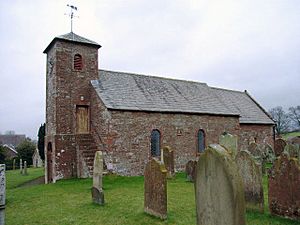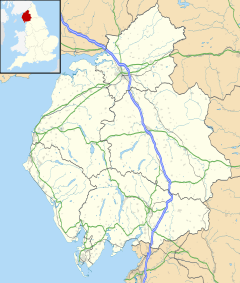Cumwhitton facts for kids
Quick facts for kids Cumwhitton |
|
|---|---|
 St.Mary's Church, Cumwhitton |
|
| Population | 310 (2011) |
| OS grid reference | NY507508 |
| Civil parish |
|
| District | |
| Shire county | |
| Region | |
| Country | England |
| Sovereign state | United Kingdom |
| Post town | BRAMPTON |
| Postcode district | CA8 |
| Dialling code | 01228 |
| Police | Cumbria |
| Fire | Cumbria |
| Ambulance | North West |
| EU Parliament | North West England |
| UK Parliament |
|
Cumwhitton is a small village in Cumbria, England. It's located near the city of Carlisle. The village is just east of the M6 highway. The closest train station is in Wetheral, about 3 miles away. In 2011, about 310 people lived in Cumwhitton. People sometimes confuse Cumwhitton with Cumwhinton, another nearby village.
Contents
Discovering Cumwhitton Village
Cumwhitton is a small but interesting place. In 2001, the village had 293 people living there. There were 152 males and 141 females. The village had 111 households at that time.
Where is Cumwhitton Located?
Cumwhitton is in the northern part of Cumbria. This area is in the North West of England. The village is about 8.8 miles southeast of Carlisle. The main road connecting Cumwhitton to Carlisle is the A69. Cumwhitton is also on the east side of the River Eden. This river flows through the village and eventually reaches the Solway Firth.
St. Mary's Church: A Historic Building
St. Mary's Church is a very old building in Cumwhitton. It is a grade 2 listed building, which means it's important for its history. The church has been around since at least the 12th century. It was largely rebuilt in the 1800s.
The church has many stained glass windows. Most of the artists who made them are unknown. The east window might be from the Anglo-Saxon period. The south wall of the church was built during the Norman times. The north part of the church, with its three arches, was built around the year 1200.
Fun Things to Do in Cumwhitton
The Pheasant Inn is a popular local public house in Cumwhitton. It serves a variety of food and local Real Ale. The pub has won awards for its Cask Ales from groups like CAMRA and Cask Marque. You can also find The Pheasant Inn listed in The Good Beer Guide.
Cumwhitton also has a place for camping called Cairndale Caravan Park. It is open from March 1st to October 31st each year. You can rent caravans there, or bring your own tent or caravan to pitch.
Exploring Cumwhitton's Past
A Viking Burial Ground Discovery
In March 2004, something amazing was found near Cumwhitton. A person using a metal detector, Peter Adams, found a special brooch on a farm. This brooch was a rare Viking oval brooch from the 9th or 10th century. These brooches are usually found in pairs and in burial sites.
So, they went back to the farm and found a second brooch. Because these brooches are so rare in England, money was given to check the site. They found a grave! Inside the grave were items buried with the person, including parts of a wooden box. More items, like a piece of a sword, were found nearby. This suggested that the grave was part of a larger cemetery. English Heritage then paid for a big excavation to carefully dig up and record this important site. It was in danger from farm plows.
In total, six burials were found. They were from the early 10th century. Sadly, most of the bones had disappeared because the soil was acidic. But the items found in the graves helped scientists guess who was buried there. It seemed to be two women and four men. The first grave was about 10 meters away from the other five. The group of five graves was neatly arranged in two rows. The middle grave in the eastern row had a shallow ditch around it. This suggests it might have once had a small mound over it. All the graves faced generally east–west. All the burials had many valuable items, like swords, spearheads, spurs, knives, and many beads. These items suggest the people were not Christian.
Some of the metal items found clearly came from Scandinavia. The oval brooches, for example, were very likely made there. However, other items, like some fabrics, knives, and spurs, were probably made in the British Isles. Many objects showed a mix of styles and origins. But some items, like the buckle sets, seemed to be made locally. This was the first sign of a craftsman or workshop in the Cumwhitton area during that time.
The findings from these excavations were published in 2014. It is planned that some of these amazing artifacts will be shown at the Tullie House Museum in Carlisle.
William James Blacklock: The Artist
William James Blacklock was an artist who painted landscapes and made lithographs. He lived in Cumwhitton for many years. He was there from 1818 to 1836, and again from 1850 to 1854. Blacklock painted beautiful scenes from Cumbria, the Lake District, and the Scottish Borders.
In 1818, Blacklock moved from London to Cumwhitton. People believe he lived in Cumwhitton House with his family. He moved back to London in 1836. But in 1850, his health got worse, so he returned to Cumwhitton. William James Blacklock passed away on March 12, 1858. He was buried in Cumwhitton on March 16, 1858. Today, thirty-three of Blacklock's artworks are on display at the Tullie House Museum and Art Gallery in Carlisle.


